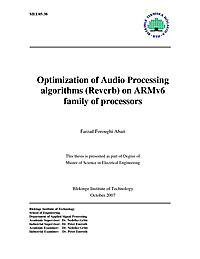
Optimization of Audio Processing algorithms (Reverb) on ARMv6 family of processors
Audio processing algorithms are increasingly used in cell phones and today’s customers are placing more demands on cell phones. Feature phones, once the advent of mobile phone technology, nowadays do more than just providing the user with MP3 play back or advanced audio effects. These features have become an integral part of medium as well as low-end phones. On the other hand, there is also an endeavor to include as improved quality as possible into products to compete in market and satisfy users’ needs. Tackling the above requirements has been partly satisfied by the advance in hardware design and manufacturing technology. However, as new hardware emerges into market the need for competence to write efficient software and exploit the new features thoroughly and effectively arises. Even though compilers are also keeping up with the new tide space for hand optimized code still exist. Wrapped in the above goal, an effort was made in this thesis to partly cover the competence requirement at Multimedia Section (part of Ericsson Mobile Platforms) to develope optimized code for new processors. Forging persistently ahead with new products, EMP has always incorporated the latest technology into its products among which ARMv6 family of processors has the main central processing role in a number of upcoming products. To fully exploit latest features provided by ARMv6, it was required to probe its new instruction set among which new media processing instructions are of outmost importance. In order to execute DSP-intensive algorithms (e.g. Audio Processing algorithms) efficiently, the implementation should be done in low-level code applying available instruction set. Meanwhile, ARMv6 comes with a number of new features in comparison with its predecessors. SIMD (Single Instruction Multiple Data) and VFP (Vector Floating Point) are the most prominent media processing improvements in ARMv6. Aligned with thesis goals and guidelines, Reverb algorithm which is among one of the most complicated audio features on a hand-held devices was probed. Consequently, its kernel parts were identified and implementation was done both in fixed-point and floating-point using the available resources on hardware. Besides execution time and amount of code memory for each part were measured and provided in tables and charts for comparison purposes. Conclusions were finally drawn based on developed code’s efficiency over ARM compiler’s as well as existing code already developed and tailored to ARMv5 processors. The main criteria for optimization was the execution time. Moreover, quantization effect due to limited precision fixed-point arithmetic was formulated and its effect on quality was elaborated. The outcomes, clearly indicate that hand optimization of kernel parts are superior to Compiler optimized alternative both from the point of code memory as well as execution time. The results also confirmed the presumption that hand optimized code using new instruction set can improve efficiency by an average 25%-50% depending on the algorithm structure and its interaction with other parts of audio effect. Despite its many draw backs, fixed-point implementation remains yet to be the dominant implementation for majority of DSP algorithms on low-power devices.
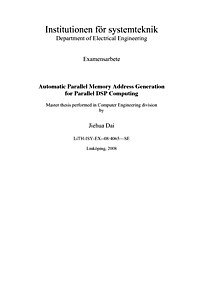
Automatic Parallel Memory Address Generation for Parallel DSP Computing
The concept of Parallel Vector (scratch pad) Memories (PVM) was introduced as one solution for Parallel Computing in DSP, which can provides parallel memory addressing efficiently with minimum latency. The parallel programming more efficient by using the parallel addressing generator for parallel vector memory (PVM) proposed in this thesis. However, without hiding complexities by cache, the cost of programming is high. To minimize the programming cost, automatic parallel memory address generation is needed to hide the complexities of memory access. This thesis investigates methods for implementing conflict-free vector addressing algorithms on a parallel hardware structure. In particular, match vector addressing requirements extracted from the behaviour model to a prepared parallel memory addressing template, in order to supply data in parallel from the main memory to the on-chip vector memory. According to the template and usage of the main and on-chip parallel vector memory, models for data pre-allocation and permutation in scratch pad memories of ASIP can be decided and configured. By exposing the parallel memory access of source code, the memory access flow graph (MFG) will be generated. Then MFG will be used combined with hardware information to match templates in the template library. When it is matched with one template, suited permutation equation will be gained, and the permutation table that include target addresses for data pre-allocation and permutation is created. Thus it is possible to automatically generate memory address for parallel memory accesses. A tool for achieving the goal mentioned above is created, Permutator, which is implemented in C++ combined with XML. Memory access coding template is selected, as a result that permutation formulas are specified. And then PVM address table could be generated to make the data pre-allocation, so that efficient parallel memory access is possible. The result shows that the memory access complexities is hiden by using Permutator, so that the programming cost is reduced.It works well in the context that each algorithm with its related hardware information is corresponding to a template case, so that extra memory cost is eliminated.
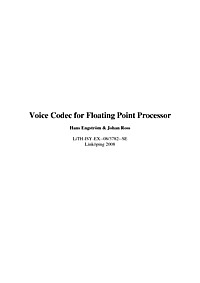
Voice Codec for Floating Point Processor
As part of an ongoing project at the department of electrical engineering, ISY, at Linköping University, a voice decoder using floating point formats has been the focus of this master thesis. Previous work has been done developing an mp3-decoder using the floating point formats. All is expected to be implemented on a single DSP.The ever present desire to make things smaller, more efficient and less power consuming are the main reasons for this master thesis regarding the use of a floating point format instead of the traditional integer format in a GSM codec. The idea with the low precision floating point format is to be able to reduce the size of the memory. This in turn reduces the size of the total chip area needed and also decreases the power consumption.One main question is if this can be done with the floating point format without losing too much sound quality of the speech. When using the integer format, one can represent every value in the range depending on how many bits are being used. When using a floating point format you can represent larger values using fewer bits compared to the integer format but you lose representation of some values and have to round the values off.From the tests that have been made with the decoder during this thesis, it has been found that the audible difference between the two formats is very small and can hardly be heard, if at all. The rounding seems to have very little effect on the quality of the sound and the implementation of the codec has succeeded in reproducing similar sound quality to the GSM standard decoder.
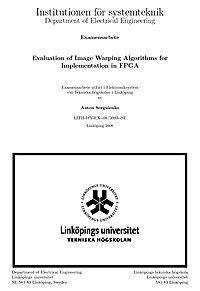
Evaluation of Image Warping Algorithms for Implementation in FPGA
The target of this master thesis is to evaluate the Image Warping technique and propose a possible design for an implementation in FPGA. The Image Warping is widely used in the image processing for image correction and rectification. A DSP is a usual choice for implantation of the image processing algorithms, but to decrease a cost of the target system it was proposed to use an FPGA for implementation. In this work a different Image Warping methods was evaluated in terms of performance, produced image quality, complexity and design size. Also, considering that it is not only Image Warping algorithm which will be implemented on the target system, it was important to estimate a possible memory bandwidth used by the proposed design. The evaluation was done by implemented a C-model of the proposed design with a finite datapath to simulate hardware implementation as close as possible.
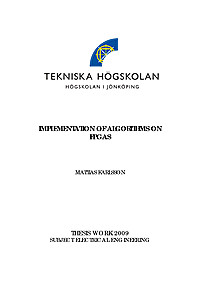
Implementation of Algorithms on FPGAs
This thesis describes how an algorithm is transferred from a digital signal processor to an embedded microprocessor in an FPGA using C to hardware program from Altera. Saab Avitronics develops the secondary high lift control system for the Boeing 787 aircraft. The high lift system consists of electric motors controlling the trailing edge wing flaps and the leading edge wing slats. The high lift motors manage to control the Boeing 787 aircraft with full power even if half of each motor’s stators are damaged. The motor is a PMDC brushless motor which is controlled by an advanced algorithm. The algorithm needs to be calculated by a fast special digital signal processor. In this thesis I have tested if the algorithm can be transferred to an FPGA and still manage the time and safety demands. This was done by transferring an already working algorithm from the digital signal processor to an FPGA. The idea was to put the algorithm in an embedded NIOS II microprocessor and speed up the bottlenecks with Altera’s C to hardware program. The study shows that the C-code needs to be optimized for C to hardware to manage the up speeding part, as the tests showed that the calculation time for the algorithm actually became longer with C to hardware. This thesis also shows that it is highly probable to use an FPGA equipped with Altera’s NIOS II safety critical microprocessor instead of a digital signal processor to control the electrical high lift motors in the Boeing 787 aircraft.
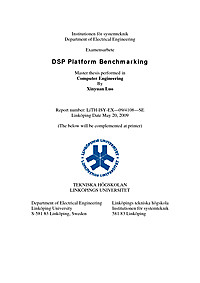
DSP Platform Benchmarking
Benchmarking of DSP kernel algorithms was conducted in the thesis on a DSP processor for teaching in the course TESA26 in the department of Electrical Engineering. It includes benchmarking on cycle count and memory usage. The goal of the thesis is to evaluate the quality of a single MAC DSP instruction set and provide suggestions for further improvement in instruction set architecture accordingly. The scope of the thesis is limited to benchmark the processor only based on assembly coding. The quality check of compiler is not included. The method of the benchmarking was proposed by BDTI, Berkeley Design Technology Incorporations, which is the general methodology used in world wide DSP industry. Proposals on assembly instruction set improvements include the enhancement of FFT and DCT. The cycle cost of the new FFT benchmark based on the proposal was XX% lower, showing that the proposal was right and qualified. Results also show that the proposal promotes the cycle cost score for matrix computing, especially matrix multiplication. The benchmark results were compared with general scores of single MAC DSP processors offered by BDTI.

Efficient arithmetic for high speed DSP implementation on FPGAs
The author was sponsored by EnTegra Ltd, a company who develop hardware and software products and services for the real time implementation of DSP and RF systems. The field programmable gate array (FPGA) is being used increasingly in the field of DSP. This is due to the fact that the parallel computing power of such devices is ideal for today’s truly demanding DSP algorithms. Algorithms such as the QR-RLS update are computationally intensive and must be carried out at extremely high speeds (MHz). This means that the DSP processor is simply not an option. ASICs can be used but the expense of developing custom logic is prohibitive. The increased use of the FPGA in DSP means that there is a significant requirement for efficient arithmetic cores that utilises the resources on such devices. This thesis presents the research and development effort that was carried out to produce fixed point division and square root cores for use in a new Electronic Design Automation (EDA) tool for EnTegra, which is targeted at FPGA implementation of DSP systems. Further to this, a new technique for predicting the accuracy of CORDIC systems computing vector magnitudes and cosines/sines is presented. This work allows the most efficient CORDIC design for a specified level of accuracy to be found quickly and easily without the need to run lengthy simulations, as was the case before. The CORDIC algorithm is a technique using mainly shifts and additions to compute many arithmetic functions and is thus ideal for FPGA implementation.
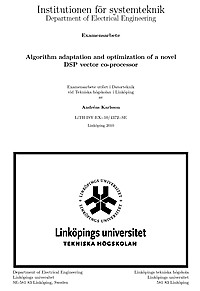
Algorithm Adaptation and Optimization of a Novel DSP Vector Co-processor
The Division of Computer Engineering at Linköping's university is currently researching the possibility to create a highly parallel DSP platform, that can keep up with the computational needs of upcoming standards for various applications, at low cost and low power consumption. The architecture is called ePUMA and it combines a general RISC DSP master processor with eight SIMD co-processors on a single chip. The master processor will act as the main processor for general tasks and execution control, while the co-processors will accelerate computing intensive and parallel DSP kernels.This thesis investigates the performance potential of the co-processors by implementing matrix algebra kernels for QR decomposition, LU decomposition, matrix determinant and matrix inverse, that run on a single co-processor. The kernels will then be evaluated to find possible problems with the co-processors' microarchitecture and suggest solutions to the problems that might exist. The evaluation shows that the performance potential is very good, but a few problems have been identified, that causes significant overhead in the kernels. Pipeline mismatches, that occurs due to different pipeline lengths for different instructions, causes pipeline hazards and the current solution to this, doesn't allow effective use of the pipeline. In some cases, the single port memories will cause bottlenecks, but the thesis suggests that the situation could be greatly improved by using buffered memory write-back. Also, the lack of register forwarding makes kernels with many data dependencies run unnecessarily slow.
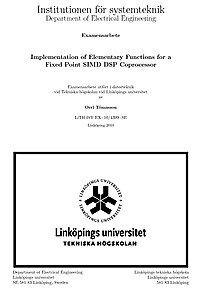
Implementation of Elementary Functions for a Fixed Point SIMD DSP Coprocessor
This thesis is about implementing the functions for reciprocal, square root, inverse square root and logarithms on a DSP platform. A multi-core DSP platform that consists of one master processor core and several SIMD coprocessor cores is currently being designed by a team at the Computer Engineering Department of Linköping University. The SIMD coprocessors’ arithmetic logic unit (ALU) has 16 multipliers to support vector multiplication instructions. By efficiently using the 16 multipliers, it is possible to evaluate polynomials very fast. The ALU does not have (hardware) support for floating point arithmetic, so the challenge is to get good precision by using fixed point arithmetic. Precise and fast solutions to implement the mathematical functions are found by converting the fixed point input to a soft floating point format before polynomial approximation, choosing a polynomial based on an error analysis of the polynomial approximation, and using Newton-Raphson or Goldschmidt iterations to improve the precision of the polynomial approximations. Finally, suggestions are made of changes and additions to the instruction set architecture, in order to make the implementations faster, by efficiently using the currently existing hardware.
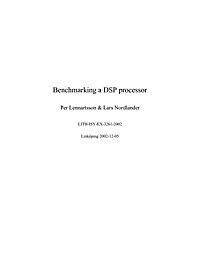
Benchmarking a DSP processor
This Master thesis describes the benchmarking of a DSP processor. Benchmarking means measuring the performance in some way. In this report, we have focused on the number of instruction cycles needed to execute certain algorithms. The algorithms we have used in the benchmark are all very common in signal processing today. The results we have reached in this thesis have been compared to benchmarks for other processors, performed by Berkeley Design Technology, Inc. The algorithms were programmed in assembly code and then executed on the instruction set simulator. After that, we proposed changes to the instruction set, with the aim to reduce the execution time for the algorithms. The results from the benchmark show that our processor is at the same level as the ones tested by BDTI. Probably would a more experienced programmer be able to reduce the cycle count even more, especially for some of the more complex benchmarks.

A Subspace Based Approach to the Design, Implementation and Validation of Algorithms for Active Vibration Isolation Control
Vibration isolation endeavors to reduce the transmission of vibration energy from one structure (the source) to another (the receiver), to prevent undesirable phenomena such as sound radiation. A well-known method for achieving this is passive vibration isolation (PVI). In the case of PVI, mounts are used - consisting of springs and dampers - to connect the vibrating source to the receiver. The stiffness of the mount determines the fundamental resonance frequency of the mounted system and vibrations with a frequency higher than the fundamental resonance frequency are attenuated. Unfortunately, however, other design requirements (such as static stability) often impose a minimum allowable stiffness, thus limiting the achievable vibration isolation by passive means. A more promising method for vibration isolation is hybrid vibration isolation control. This entails that, in addition to PVI, an active vibration isolation control (AVIC) system is used with sensors, actuators and a control system that compensates for vibrations in the lower frequency range. Here, the use of a special form of AVIC using statically determinate stiff mounts is proposed. The mounts establish a statically determinate system of high stiffness connections in the actuated directions and of low stiffness connections in the unactuated directions. The latter ensures PVI in the unactuated directions. This approach is called statically determinate AVIC (SD-AVIC). The aim of the control system is to produce antidisturbance forces that counteract the disturbance forces stemming from the source. Using this approach, the vibration energy transfer from the source to the receiver is blocked in the mount due to the anti-forces. This thesis deals with the design of controllers generating the anti-forces by applying techniques that are commonly used in the field of signal processing. The control approaches - that are model-based - are both adaptive and fixed gain and feedforward and feedback oriented. The control approaches are validated using two experimental vibration isolation setups: a single reference single actuator single error sensor (SR-SISO) setup and a single reference input multiple actuator input multiple error sensor output (SR-MIMO) setup. Finding a plant model can be a problem. This is solved by using a black-box modelling strategy. The plants are identified using subspace model identification. It is shown that accurate linear models can be found in a straightforward manner by using small batches of recorded (sampled) time-domain data only. Based on the identified models, controllers are designed, implemented and validated. Due to resonance in mechanical structures, adaptive SD-AVIC systems are often hampered by slow convergence of the controller coefficients. In general, it is desirable that the SD-AVIC system yields fast optimum performance after it is switched on. To achieve this result and speed up the convergence of the adaptive controller coefficients, the so-called inverse outer factor model is included in the adaptive control scheme. The inner/outer factorization, that has to be performed to obtain the inverse outer factor model, is completely determined in state space to enable a numerically robust computation. The inverse outer factor model is also incorporated in the control scheme as a state space model. It is found that fast adaptation of the controller coefficients is possible. Controllers are designed, implemented and validated to suppress both narrowband and broadband disturbances. Scalar regularization is used to prevent actuator saturation and an unstable closed loop. In order to reduce the computational load of the controllers, several steps are taken including controller order reduction and implementation of lower order models. It is found that in all experiments the simulation and real-time results correspond closely for both the fixed gain and adaptive control situation. On the SR-SISO setup, reductions up to 5.0 dB are established in real-time for suppressing a broadband disturbance output (0-2 kHz) using feedback-control. On the SR-MIMO vibration isolation setup, using feedforward-control reductions of broadband disturbances (0-1 kHz) of 9.4 dB are established in real-time. Using feedback-control, reductions are established up to 3.5 dB in real-time (0-1 kHz). In case of the SR-MIMO setup, the values for the reduction are obtained by averaging the reductions obtained in all sensor outputs. The results pave the way for the next generation of algorithms for SD-AVIC.
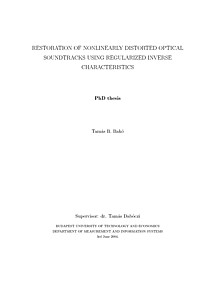
Restoration of Nonlinearly Distorted Optical Soundtracks Using Regularized Inverse Characteristics
This dissertation is concerned with the possibilities of restoration of degraded film-sound. The sound-quality of old films are often not acceptable, which means that the sound is so noisy and distorted that the listener have to take strong efforts to understand the conversations in the film. In this case the film cannot give artistic enjoyment to the listener. This is the reason that several old films cannot be presented in movies or television. The quality of these films can be improved by digital restoration techniques. Since we do not have access to the original signal, only the distorted one, therefore we cannot adjust recording parameters or recording techniques. The only possibility is to post-compensate the signal to produce a better estimate about the undistorted, noiseless signal. In this dissertation new methods are proposed for fast and efficient restoration of nonlinear distortions in the optically recorded film soundtracks. First the nonlinear models and nonlinear restoration techniques are surveyed and the ill-posedness of nonlinear post-compensation (the extreme sensitivity to noise) is explained. The effects and sources of linear and nonlinear distortions at optical soundtracks are also described. A new method is proposed to overcome the ill-posedness of the restoration problem and to get an optimal result. The effectiveness of the algorithm is proven by simulations and restoration of real film-sound signals.
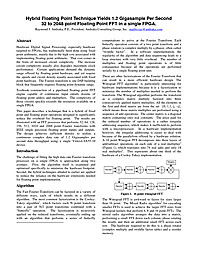
Hybrid Floating Point Technique Yields 1.2 Gigasample Per Second 32 to 2048 point Floating Point FFT in a single FPGA
Hardware Digital Signal Processing, especially hardware targeted to FPGAs, has traditionally been done using fixed point arithmetic, mainly due to the high cost associated with implementing floating point arithmetic. That cost comes in the form of increased circuit complexity. The increase circuit complexity usually also degrades maximum clock performance. Certain applications demand the dynamic range offered by floating point hardware, and yet require the speeds and circuit density usually associated with fixed point hardware. The Fourier transform is one DSP building block that frequently requires floating point dynamic range. Textbook construction of a pipelined floating point FFT engine capable of continuous input entails dozens of floating point adders and multipliers. The complexity of those circuits quickly exceeds the resources available on a single FPGA. This paper describes a technique that is a hybrid of fixed point and floating point operations designed to significantly reduce the overhead for floating point. The results are illustrated with an FFT processor that performs 32, 64, 128, 256, 512, 1024 and 2048 point Fourier transforms with IEEE single precision floating point inputs and outputs. The design achieves sufficient density to realize a continuous complex data rate of 1.2 Gigasamples per second data throughput using a single Virtex4-SX55-10 device.
Audio Time-Scale Modification
Audio time-scale modification is an audio effect that alters the duration of an audio signal without affecting its perceived local pitch and timbral characteristics. There are two broad categories of time-scale modification algorithms, time-domain and frequency-domain. The computationally efficient time-domain techniques produce high quality results for single pitched signals such as speech, but do not cope well with more complex signals such as polyphonic music. The less efficient frequencydomain techniques have proven to be more robust and produce high quality results for a variety of signals; however they introduce a reverberant artefact into the output. This dissertation focuses on incorporating aspects of time-domain techniques into frequency-domain techniques in an attempt to reduce the presence of the reverberant artefact and improve upon computational demands. From a review of prior work it was found that there are a number of time-domain algorithms available and that the choice of algorithm parameters varies considerably in the literature. This finding prompted an investigation into the effects of the choice of parameters and a comparison of the various techniques employed in terms of computational requirements and output quality. The investigation resulted in the derivation of an efficient and flexible parameter set for use within time-domain implementations. Of the available frequency-domain approaches the phase vocoder and timedomain/ subband techniques offer an efficiency and robustness advantage over sinusoidal modelling and iterative phase update techniques, and as such were identified as suitable candidates for the provision of a framework for further investigation. Following from this observation, improvements in the quality produced by time-domain/subband techniques are realised through the use of a bark based subband partitioning approach and effective subband synchronisation techniques. In addition, computational and output quality improvements within a phase vocoder implementation are achieved by taking advantage of a certain level of flexibility in the choice of phase within such an implementation. The phase flexibility established is used to push or pull phase values into a phase coherent state. Further improvements are realised by incorporating features of time-domain algorithms into the system in order to provide a ‘good’ initial set of phase estimates; the transition to ‘perfect’ phase coherence is significantly reduced through this scheme, thereby improving the overall output quality produced. The result is a robust and efficient time-scale modification algorithm which draws upon various aspects of a number of general approaches to time-scale modification.
A DGPS/Radiobeacon Receiver for Minimum Shift Keying with Soft Decision Capabilities
The Global Positioning System (GPS) is now in operation, and many improvements to its performance are being sought. One such improvement is Differential GPS (DGPS), where known errors in the GPS broadcast are identified and the corrections broadcast to the end user. One implementation of DGPS being considered is the use of coastal marine radio direction finding (RDF) radiobeacons in the 285-325kHz band as transmitters for the DGPS broadcast. The normal RDF beacon signal consists of a continuous carrier on a one kilohertz boundary plus a Morse-code identification signal 1025Hz above the carrier. In the DGPS/radiobeacon implementation proposed for the US coastal regions, the differential data link signal uses minimum shift keying (MSK) at a data rate of 25, 50, 100, 200 or 400 baud (the exact baud rat has not yet been decided). This MSK signal is centered between the RDF beacon carrier and identification signal. At the frequencies that these radiobeacons are operated, the prevailing atmospheric noise is both non-Gaussian and very strong. This noise characteristic makes the design of a long-range data link difficult. One solution that has been proposed is the use of forward error correction (FEC) coding of the data. The performance of FEC decoders can be improved by the used of a soft decision receiver, which delivers both bit decisions and information about the validity of the bit decisions. This work describes the design of a radio receiver for DGPS/Radiobeacon servics which is capable of reception of 400 baud MSK in the DGPS/Radiobeacon band. The receiver is designed to be easily augmented to provide soft decisions and easily modified to recieve MSK at data rates of 25 to 400 baud. The radio is a microprocessor controlled dual conversion superheterodyne with an audio frequency of 1kHz. The demodulator runs on the same microprocessor that controls the radio. The weak-signal performance of the demodulator is very good: the Eb/No vs. bit error rate performance of the demodulator is only a couple of dB worse than the theoretical performance of differential phase-shift keying. The radio has a noise floor of -114dBm referenced to it's 500Hz wide audio bandwidth and a 3rd order intermodulation intercept of +7dBm for a dynamic range of 83dB. This work concludes with a thumbnail analysis of the operations needed to implement a soft bit decision estimator, and some suggestions for the implementation of said soft bit decision estimator.
IMPLEMENTATION OF PERIODOGRAM SMOOTHING OF NOISYIMPLEMENTATION OF PERIODOGRAM SMOOTHING OF NOISY SIGNALS USING TMS320C6713 DSK
Periodogram Smoothing is a technique of power spectrum estimation. The discrete Fourier transform of a digital signal simply resolves the frequency components. The algorithm is implemented on Texas Instruments’ TMS320C6713 DSP Starter Kit (DSK). This is a 32-bit floating-point digital signal processor running at 225 MHz. The programs are basically written in the C programming language. However, those sections of code which are time-critical and memory-critical are written in assembly language of C6713. A MATLAB™ graphical user interface is also provided. The MATLAB™ program calls C programs loaded in Code Composer Studio (CCS). The C programs in turn call the assembly programs when required.
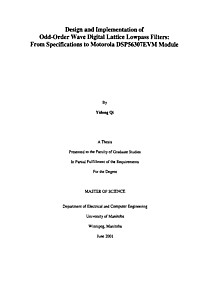
Design and implementation of odd-order wave digital lattice lowpass filters, from specifications to Motorol DSP56307EVM module
This thesis is dedicated to applying and developing explicit formulas for the design and implementation of odd-order lattice Lowpass wave digital filters (WDFs) on a Digital Signal Processor (DSP), such as a Motorola DSP56307EVM (Evaluation Module). The direct design method of Gazsi for filter types such as Butterworfh, Chebyshev, inverse Chebyshev, and Cauer (Elliptic) provides a straightforward method for calculating the coefficients without an extensive knowledge of digital signal processing. A program package to design and implement odd-order WDFs, including detailed procedures and examples, is presented in this thesis and includes not only the calculations of the coefficients, but also the simulation on a MATLAB platform and an implementation on a Motorola DSP56307EVM board. It is very quick, effective and convenient to obtain the coefficients when the user enters a few parameters according to the general specifications; to verify the characteristics of the designed filter; to simulate the filter on the MATLAB platform; to implement the filter on the DSP board; and to compare the results between the simulation and the implementation.
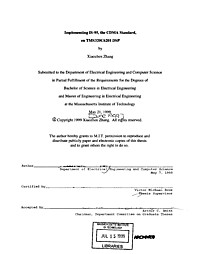
Implementing IS-95, the CDMA Standard, on TMS320C6201 DSP
IS-95 is the present U.S. 2nd generation CDMA standard. Currently, the 2nd generation CDMA phones are produced by Qualcomm. Texas Instruments (TI) has ASIC design for Viterbi Decoder on C54x. Several of the components in the forward link process are also implemented in hardware. However, having to design a specific hardware for a particular application is expensive and time consuming. Thus, the possibility of the alternative implementations is of great interest to both customers and TI itself. This research has achieved in successful implementation of IS-95 entirely in software on TI fixed-point DSP TMS320C6201, and met the real time constraint. IS-95 system, the industrial standard for CDMA, is a very complicated system and extremely computationally demanding. The transmission rate for an IS-95 system is 1.2288 Mcps. This research project includes all the major components of the demodulation process for the forward link system: PN Descrambling, Walsh Despreading, Phase Correction & Maximal Ratio Combining, Deinterleaver, Digital Automatic Gain Control, and Viterbi Deccc:r. The entire demodulation process is done completely in C. That makes it a very attractive alternative implementation in the future applications. It is well known that ASIC design is not only expensive and but also time consuming, programming in assembly is easier and cheaper, but programming in C is a much easier and efficient way out, in particular, for general computer engineers. During the whole process, efforts have been devoted on developing various specific techniques to optimize the design for all the components involved. These developments are successfully achieved by making the best use of the following techniques: to simplify the algorithms first before programming, to look for regularity in the problem, to work toward the Compiler's full efficiency, and to use C intrinsics whenever possible. All these attributes together make the implementation scheme great for DSP applications. The benchmark results compare very well to the TI-internal hand scheduled assembly performance of the same type of decoders. The estimated percentage usage of all the components (excluding PN) is only 21.18% of the total CPU cycles available (4,000 K), which is very efficient and impressive.
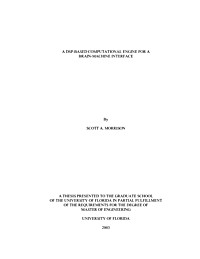
A DSP-Based Computational Engine For a Brain-Machine Interface
The fields of neurobiology and electrical engineering have come together to pursue an integrated Brain-Machine Interface (BMI). Signal processing methods are used to find mapping algorithms between motor cortex neural firing rate and hand position. This cognitive extension could help patients with quadriplegia regain some independence using a thought-controlled robot arm. Current signal processing methods to achieve realtime neural-to-motor translation involve large, multi-processor systems to produce motor control parameters. Eventually, software running in a portable signal processing system is needed to allow for the patient to have the BMI in a backpack or attached to a wheelchair. This thesis presents a DSP-Based Computational Engine for a Brain-Machine Interface. The development of a DSP Board based on the Texas Instruments TMS320VC33 DSP will be presented, along with implementations of two digital filters and their training methods: 1) FIR trained with Normalized Least Mean Square Adaptive Filter (NLMS) and 2) Recurrent Multi-Layer Perceptron (RMLP) trained with Real-Time Recurrent Learning (RTRL). The requirements of the DSP Board, component selection and integration, and control software are discussed. The DSP implementations of the digital filters are presented, along with performance and timing analysis in real data collected from an Owl Monkey at Duke University. The weights of the FIR-NLMS filter converged similarly on the DSP as they did in MATLAB. Likewise, the weights of the RMLP-RTRL filter converged similarly on the DSP as they did using the Backpropagation Through Time method in NeuroSolutions. The custom DSP Board and two digital algorithms implemented in this thesis create a starting point for an integrated, portable, real-time signal processing solution for a Brain-Machine Interface.
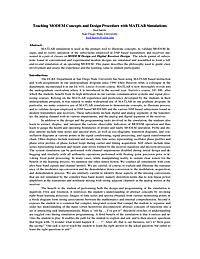
Teaching MODEM Concepts and Design Procedure with MATLAB Simulations
MATLAB simulation is used as the primary tool to illustrate concepts, to validate MODEM designs, and to vent' operation of the subsystems employed in DSP based transmitters and receivers presented in a pair of classes on MODEM Design and Digital Receiver Design. The whole gamut of subsystems found in conventional and experimental modem designs are simulated and assembled to form a full end-to-end simulation of an operating MODEM. This paper describes the philosophy used to guide class involvement and assess the experience and the learning value to student participants.



















